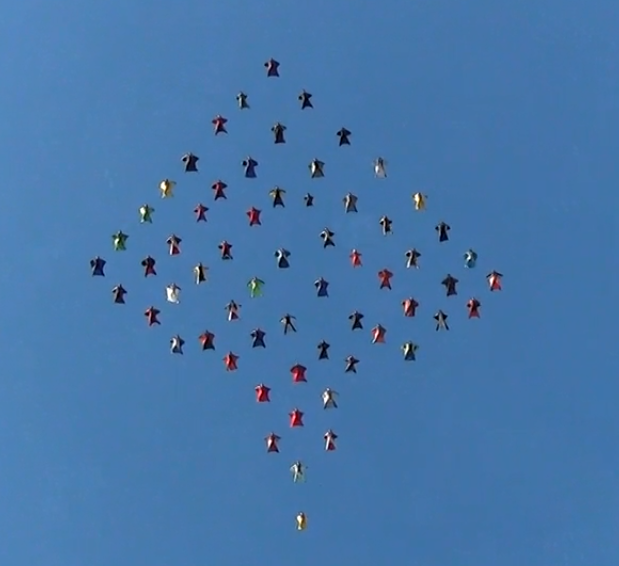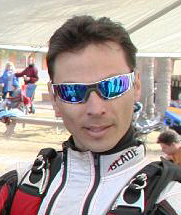Recommended Posts
mccordia 73
People use sight/eyelines to line up for a row/slot, or at least most pictures indicate so.
And sight/eyelines are usualky whats enforced in briefings as well.
Thats also a flaw in the current grid system.
A 2.1 meter guy has more room for movement, compared to a 1.50 meter lady.
Though this one does seem to favour us tall Dutch people in terms of having more roo
to move, I dont think its a good one.
Headcount seems to work better indeed.
FlyLikeBrick
I'm an Athlete?
JohanW 0
It's an advantage is you have to touch your grid cell; it becomes a disadvantage if you have to be in it.QuoteThats also a flaw in the current grid system. A 2.1 meter guy has more room for movement, compared to a 1.50 meter lady.
I am. I think.
mccordia 73
Although we do have a lot of people with big heads in this sport[/:P]
FlyLikeBrick
I'm an Athlete?
At the risk of making this even more complicated than it needs to be, there may be another mathematical way to address this that could possibly work but would require more information be known, but at least we would know where each persons navel/central points were. Vitruvian Man
QuoteThen again, in the human body the central point is naturally the navel. For if a man be placed flat on his back, with his hands and feet extended, and a pair of compasses centred at his navel, the fingers and toes of his two hands and feet will touch the circumference of a circle described therefrom. And just as the human body yields a circular outline, so too a square figure may be found from it. For if we measure the distance from the soles of the feet to the top of the head, and then apply that measure to the outstretched arms, the breadth will be found to be the same as the height, as in the case of plane surfaces which are perfectly square
The other alternative is to do something commonly done in the precision shooting of humans with a scoped weapon system and tweaking it a tad. That being the determination of an average distance from a persons head to the navel and applying that to all the jumpers as a universal central point of each jumper.
Just food for thought/thinking out loud.
Some people dream about flying, I live my dream
SKYMONKEY PUBLISHING
Buried 0
Where is my fizzy-lifting drink?
Quotei thought about using the center of a person, but then it becomes overly complicated to find the center of each flyer and where their center truly would be in the formation before you start plotting. That's were a % or somehow exact measurable tolerance comes in to allow for that.
Well if we know what the average distance from a persons head to their navel is that can be replicated by placing a dot on the persons head to a dot that represents that distance and go from there. Yes there is margin of error but it is very small,thats why it is an average. Another way to look at it is that most peoples BOC/ bottom of their rig is in the general height location of their navel. More food for regurgitation.
Some people dream about flying, I live my dream
SKYMONKEY PUBLISHING
kallend 1,620
Quote
The other alternative is to do something commonly done in the precision shooting of humans with a scoped weapon system and tweaking it a tad.
Would save having to axe people who aren't in their slot.
The only sure way to survive a canopy collision is not to have one.
mccordia 73
You're never sure if someone has his feet 10%, 20% or 99% up.
So getting an actual centered navel position is hard to do. Also when combined with camera helmets that hide the actual head height.
And thats not even getting into wingsuits where the tailwing length exeeds the height of the person, and may even hide the actual position of the feet. Getting 'a' center position, in terms of profile presented to the camera, may be possible. But I dont think the added difficulty and potential inaccuracies outweigh the simple head measurement (potentialy aided by a sticker).
Looking across a line in a formation, I see faces lined up. It seems to be what most people actually fly. Flying next to a shorter or taller person, I know I do.
FlyLikeBrick
I'm an Athlete?
QuoteAnother way to look at it is that most peoples BOC/ bottom of their rig is in the general height location of their navel. More food for regurgitation.
Some people dream about flying, I live my dream
SKYMONKEY PUBLISHING
mccordia 73
QuoteQuoteAnother way to look at it is that most peoples BOC/ bottom of their rig is in the general height location of their navel. More food for regurgitation.
Ive owned 3 different brands of containers (Vortex II, Wings, Vector 3), and the BOC location varied greatly depending on just the brand.
Id make a guesstemate of up to 30 cm or more between the two extremes.
The VortexII BOC almost hanging past my cuddly bottom. The Wings BOC sitting halfway up my back.
Combining just the container design with different sized canopies those same containers are made for, I think its appearant we should quit regurgitating that one, as its hard to impossible to really get an accurate centering there.
Also in terms of finding an easy/big trackingpoint thats not hidden inside a wingsuit. I wouldnt want to be the one charged with finding Jebs black BOC on his black container on his black wingsuit
Heads seem to work quite well in the examples we tried.
Both in shape and location. It seems to work in terms of how we fly, using our eyes for positioning. And it seems to work well in terms of locating the point. Always in the same location, sticking out, in a similar size thats easy to center.
Heads also make a much easier to find centerpoint for evalutation on pictures taken from underneath, by a cameraman looking up. Something quite common.
I think only gripped hands between flyers would be a more absolute location for validation....
FlyLikeBrick
I'm an Athlete?
kallend 1,620
QuoteQuoteQuoteAnother way to look at it is that most peoples BOC/ bottom of their rig is in the general height location of their navel. More food for regurgitation.
Ive owned 3 different brands of containers (Vortex II, Wings, Vector 3), and the BOC location varied greatly depending on just the brand.
Id make a guesstemate of up to 30 cm or more between the two extremes.
The VortexII BOC almost hanging past my cuddly bottom. The Wings BOC sitting halfway up my back.
Combining just the container design with different sized canopies those same containers are made for, I think its appearant we should quit regurgitating that one, as its hard to impossible to really get an accurate centering there.
Also in terms of finding an easy/big trackingpoint thats not hidden inside a wingsuit. I wouldnt want to be the one charged with finding Jebs black BOC on his black container on his black wingsuit
Heads seem to work quite well in the examples we tried.
Both in shape and location. It seems to work in terms of how we fly, using our eyes for positioning. And it seems to work well in terms of locating the point. Always in the same location, sticking out, in a similar size thats easy to center.
Heads also make a much easier to find centerpoint for evalutation on pictures taken from underneath, by a cameraman looking up. Something quite common.
I think only gripped hands between flyers would be a more absolute location for validation....
What about differences in wing sweep?
My eyes are in my head. I find it easy to align my head with a line of heads. I'm not sure I can so easily align my navel with a line of navels.
The only sure way to survive a canopy collision is not to have one.
The111 0
QuoteMy eyes are in my head. I find it easy to align my head with a line of heads. I'm not sure I can so easily align my navel with a line of navels.
Exactly.
mccordia 73
FlyLikeBrick
I'm an Athlete?
If you can find a persons head in a photo, you surely can find the bottom of their container/butt. I'd wager the difference in measuring using the head and the BOC/butt would show one to be more precise in positioning individuals in the formation.
Some people dream about flying, I live my dream
SKYMONKEY PUBLISHING
mccordia 73
QuoteAre we talking about reference points while flying or for evaluating the picture of the formation? I was under the impression we were talking about evaluating the photo?
This statement seems to suggest the exact opposite?
Why would you want to use different criteria for judging, than the ones briefed for the formation.
As others also point out, nobody flies navel to navel. Sightlines are what we use in both briefing and execution during the jump.
Suddenly using a different point, that (depending on someones height) may cause deviations from the actual position flown by a person just makes no sense.
QuoteIf you can find a persons head in a photo, you surely can find the bottom of their container/butt.
I beg to differ. Give it a try on some pictures.
And how would we judge pictures taken from the bottom up?
The formation against a clean sky is a much better picture to judge than the topview over detailed terrain. Though both can and will be used, depending on cameraman skill/preference.
QuoteI'd wager the difference in measuring using the head and the BOC/butt would show one to be more precise in positioning individuals in the formation.
I seem to recall you briefing people to look for eachothers eyelines as well? Or at least, thats how every load organiser Ive met so far does it? When did you switch to navels?
Taking the head as the point of origin, the butt/navel/BOC position will cause variations, be more open to interpetation/tweaking on judging, and it doesnt match the actual reference point people are using/flying to. And depending on the photo/video (we've been looking at quite a few formation pictures lately) you will notice by trying to find definable points, that a lot of pictures (especially on bigger formations) lack resolution to properly evaluate. Even when viewed at full resolution.
This gets worse when evaluating based on video.
The head is the last point which is clearly defined, even when a wingsuit is only 10 pixels in size on video, you're still able to point it out.
Both in terms of accuracy in judging and the actual practical realisation, its more time-consuming, less accurate and counter-productive as its much more open interpetation.
FlyLikeBrick
I'm an Athlete?






Actually it is terribly different... the key being that when people line up in formation, they use their heads for visual references, not their rigs. So if a giant and midget were in the same formation and lined up their heads perfectly, their rigs would be WAY out of line.
For that reason I agree the heads should be used for "dotting."
Share this post
Link to post
Share on other sites